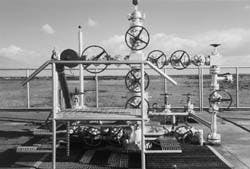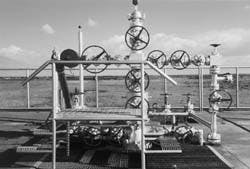Anton J. Dach Jr., Timothy Haeberle
ABB Vetco Gray
Houston
This well completion includes ABB Vetco Gray valves manufactured according to the latest API specifications.
Revisions in the API 6A, 17th Edition, have resolved a number of long-term problems and expanded its scope and coverage of wellhead and christmas tree equipment.
The 17th Edition, Feb. 1, 1996, represents the state-of-the-art in international requirements for wellhead and christmas tree equipment. The design, materials, and quality control aspects of API 6A have all been improved with an emphasis on making the document more acceptable around the world.
However, there are unresolved issues that raise many questions about the future direction of efforts aimed at international standardization of wellhead and christmas tree equipment. Unfortunately, these unresolved issues confuse both manufacturers and companies purchasing this equipment. This ultimately increases wellhead and christmas tree costs, so it is to everyone's advantage to resolve these issues.
This article describes the significant revisions that are included in API 6A, 17th Edition. Also discussed are the regulatory, standardization, and customer acceptance issues that cloud the future of API 6A, 17th Edition.
Background
The roots of the current API 6A can be traced back to 1939, when API issued Standard 5-G-2, "Standards On Well Control Valves, Flanged Non-Rising-Stem Solid Wedge Steel Gate Valves For Drilling And Production Well Control Service," and to 1962 when the 1st Edition of API Specification 6A was released.
The 17th Edition includes an expanded listing of components and includes three new appendices that drastically improve the document. This edition contains changes that have been balloted and approved by API Committee 1, Subcommittee 6 (C1 5C6) since Supplement 2 to API 6A, 16th Edition, was released in 1992. These changes can be subdivided into broad categories based on the reasons for being developed, as follows:
- Eliminate conflicting requirements between 6A and other API standards
- Expand coverage to promote increased safety, standardization, and/or improved quality control
- Facilitate international or global usage
- Facilitate new, im proved, or more cost-effective manufacturing processes.
Conflicting requirements
Many API specifications are now interrelated because of references back and forth to specific sections in the various documents. Although this interrelation helps to promote standardization, there are some negative effects.
In some instances, problems can be caused when several standards start off with identical requirements, but then fail to stay synchronized because of different revision schedules. Correcting problems such as these were part of the focus of the 17th Edition.
API 14D replaced
In the 17th Edition, one significant change is the addition of design, materials, welding, and quality control requirements for surface safety valves (SSVs) and underwater safety valves (USVs). API 14D previously covered these requirements, but conflicts between supposedly similar requirements in 6A and 14D have been a confusing and costly problem for equipment manufacturers.
Although the two API committees responsible for these two documents had attempted to duplicate the requirements, different revision schedules had a synchronization problem, with API 14D lagging behind.
With the 17th Edition, the basic SSV and USV design and manufacturing requirements have been unified in the API 6A with PSL 2 as a minimum. PSLs are product specified levels listed in API 6A.
The verification testing requirements that were in Section 900 of API 14D, 9th Edition are now in the new API 6AV1 1st Edition, "Specification for Verification Test of Wellhead Surface Safety Valves and Underwater Safety-Valves for Offshore Service."
The new API 6A and 6AV1 requirements maintain the basic design, material, quality, and testing levels required in API 14D, 9th Edition; therefore, the standards have not been weakened.
It should be noted that existing SSV and USV design verification testing completed under API 14D will satisfy the requirements of the new API 6AV1. Therefore, existing designs will not have to be requalified by the manufacturers to switch from API 14D.
As part of this move from API 14D to API 6A and API 6AV1, the recommended practice for failure reporting that was covered in Appendix C of API 14D is now covered by Appendix L of API 6A.
In summary, while two documents must still be referenced to cover SSV and USV equipment, the costly problem of conflicting design, materials, welding, and quality control requirements has been solved. The only downside is the problems that may arise during the transition period that will exist until API 14D can be withdrawn.
Temperature classes
When API 17D, 1st Edition, was released in 1992, it referenced back to API 6A for most of the materials, welding, and quality control requirements; however, API 17D introduced a new "operating temperature rating," not covered in API 6A.
To correct this situation, API 6A, 17th Edition adds an Operating Temperature Class Rating "V" that covers from 35 to 250 F. (2-121 C.). To meet the API 17D impact testing requirements, API 6A also includes a new requirement that equipment for Operating Temperature Class V shall be impact tested at 0 F. (-18 C.).
Screwed wellheads
Independent screwed wellhead equipment has been manufactured for years to requirements much different than specified for API 6A equipment.
In spite of API 6A containing requirements for independent screwed wellhead equipment, these components were typically manufactured to requirements very similar to API Spec 11 equipment. Therefore, all requirements for independent screwed wellhead equipment have been removed from the 17th Edition and plans call for these requirements to be issued as a stand-alone document, API Spec 11 IW.
Safety, standardization, and quality
Product safety, standardization (or interchangeability), and a high level of quality control are the primary interests of customers purchasing API 6A equipment. In these areas, the 17th Edition provides a number of improvements.
Elevated temperatures
A significant addition to the 17th Edition is Appendix G for new design and equipment rating options for elevated temperature service. These new options are the result of a long-term, in-depth collaboration between the C1 SC6 materials task group and the C1 SC6 design task group.
The 16th Edition was limited in that it only provided a standardized means of rating 6B flanges at 2,000, 3,000, and 5,000 psi for service above 250 F., (121 C.). The new provisions in Appendix G provide the manufacturer with options for rating all API 6A equipment.
Furthermore, the manufacturer can select various options to provide the customer equipment with the best derated working pressure, or in many cases, equipment with a full-rated working pressure. The new options include:
- Design using derating factors published in the specification.
- Design using elevated temperature tensile test data on a QTC representing the actual component.
- Design based on elevated temperature tensile test data on the material grade being used.
Choke trim
The 17th Edition now contains quality control requirements for choke trim. Choke trim is defined as "pressure controlling choke components, including choke beans." Choke trim was not included in prior editions of API 6A.
The new requirements stipulate that choke trim must be subjected to the same surface non-destructive evaluation (NDE) and serialization requirements as valve bore sealing mechanisms, with an exemption for brazed, press-fit, and shrink-fit joints from the surface NDE requirements.
Actuators
In many cases, valves and the actuators used to operate them are manufactured by different companies. Unfortunately, the requirements in prior editions of API 6A made it difficult to monogram these components independently.
The 17th Edition now includes specific requirements for valves adapted for actuators, allowing them to be monogrammed after testing with a "simulated" bonnet instead of with an actuator.
The valve adapted for an actuator must successfully complete all tests except for the backseat test. If the bonnet and actuator are furnished as a unit for PSL 4, then a gas backseat test shall be conducted.
In addition to these new requirements, a number of revisions were made to clarify the intent of the requirements for valves adapted for actuators.
Crossover connection
Restricted area packoffs are a proprietary part of manufacturers' designs, and the requirements specified in the 16th Edition failed to provide adequate flexibility for the various designs.
The maximum seal area requirements shown in the 16th and earlier editions were an attempt to show "how to" in the strength of design. In some cases, the dimensions shown did not correlate with calculations. These dimensions were undocumented and appear to be incorrect.
The minimum crossover connection seal diameter is dependent on the restricted area packoff design. The manufacturer must account for all loading on each component of the lower connection. Section 300 of the 17th Edition covers these requirements, and no specific dimensions need to be provided.
The requirements in the 17th Edition properly identify what must be accounted for, but leaves the "how to" up to each manufacturer, based on his particular design or designs.
Segmented flanges
New analysis of old designs can sometimes render them obsolete, and this has happened to segmented flanges. After a detailed study, triple and quadruple segmented flanges have been deleted from the 17th Edition. The high-strength bolting required for triple and quadruple flanges simply does not meet the requirements for H2S service.
Present surveys indicate triple and quadruple segmented flanges are less than 10% of the total segmented flanges being manufactured. Therefore, only a small portion of the market will be affected.
This change does not affect dual segmented flanges.
Other end connectors
The original intent for the 16th Edition was to allow other end connectors (OECs) to be used on mandrel hangers when they met the specified requirements. Unfortunately, the wording did not reflect this intent.
This has been corrected in the 17th Edition to clearly show that mandrel casing hangers and mandrel tubing hangers can now be monogrammed with any threaded connections, provided that they meet the specified design requirements.
Adapters and spacers
Adapter spools had been listed as an API 6A product in prior editions, but were not covered by detailed requirements. A new section in the 17th Edition permits manufacturing this important class of equipment under API rules.
Previous requirements did not permit changing the pressure ratings in a wellhead component without a means of sealing the restricted area. In addition, a simple spacer spool was not covered by the previous requirements because heads and housings were required to have a means for suspending casing or tubing within them. The practice was to make this equipment under API rules prior to the 15th Edition.
The key provision of the new requirements is to limit the working pressure rating of the body to the lowest rating of the end and outlet connectors rather than the highest as is permitted in a crossover spool.
Hardness testing
To ensure that components destined for sour service meet the required maximum hardness values, wording has been added to a number of sections to clarify that hardness testing of individual components is required.
While NACE MR0175 has been interpreted to allow hardness sampling, it is quite clear now in particular sections of API 6A that each part must be individually tested.
Elastomers
A small yet significant addition was made to the requirements for storage and age control of elastomeric materials.
While the requirements for storage and age control were left up to the manufacturer in prior API 6A revisions, the 17th Edition now includes detailed requirements as to how elastomers should be stored to prevent rapid deterioration.
Equipment markings
The equipment marking requirements have been revised in the 17th Edition to clarify exactly what is necessary for each piece of equipment.
Also, the 17th Edition contains new requirements for several items for which no marking was identified in the prior revisions.
Repair and remanufacture
A new Appendix J has been added to clarify applicability of requirements in API 6A-vs.-guidelines in API RP 6AR for repair and remanufacture of wellhead and christmas tree equipment.
Equipment made prior to the 15th Edition of 6A can be repaired or remanufactured under the guidelines established in API RP 6AR. Equipment made to the 15th and later Editions of 6A can be repaired or remanufactured to the requirements of API Spec 6A, Section 11.
This new appendix explains clearly the options related to repair and remanufacture, and provides answers to the most commonly asked questions.
International usage
For a number of years, a key API staff and committee member objective has been to make API 6A and other API specifications international in scope, with acceptance and usage throughout the world.
Much progress has been made with respect to this objective, but the 16th Edition of API 6A still contained several requirements that reflected its prior U.S. focus. Several changes were made to facilitate international acceptance by both the manufacturers and the users of API 6A equipment.
Renumbering
To facilitate the acceptance of API 6A, 17th Edition, as the replacement for the current ISO 10423, the 17th Edition has been totally renumbered and formatted using the ISO guidelines.
While this step fulfilled the ISO related objectives, it should be noted that the renumbering has placed 6A out of synchronization with API 17D 1st Edition. API 17D relies heavily on references to specific parts of API 6A.
Equivalent standards
Prior to the 17th Edition, any manufacturer wishing to use an equivalent to one of the U.S.-based reference standards listed in 6A had to submit the proposed equivalent to API for review.
The new policy transfers the responsibility for evaluating and justifying the equivalency of alternate national or international standards from API to the individual manufacturers.
International standards
Throughout the entire API 6A, 17th Edition, any prior reference to an "industry recognized standard" has been changed to read "nationally or internationally recognized standard."
PSL 3 gas test
An optional gas test has been added to PSL 3 in the 17th Edition. This optional test was included to satisfy a broad base of API 6A user and manufacturer requirements in the North Sea area. It allows for the following:
- A high and low pressure (300 psi) gas seat test in addition to or in place of the extended hydrostatic seat test
- A gas body test in addition to the hydrostatic body test
- A gas backseat test in conjunction with the gas body test.
H2S radius of exposure
One factor in determining the appropriate PSL for equipment is "close proximity," and one factor in determining "close proximity" is the "radius of exposure" (ROE).
In the 16th Edition, Appendix A, the only option allowed for determining the ROE was based on the procedure published by the Texas Railroad Commission. In the 17th Edition, Appendix A has been revised to identify that other ROE calculating methods may apply, depending on local regulations.
Manufacturing processes
The 15th Edition of API 6A issued in 1986 contained a major expansion into the area of manufacturing process control. Many of the process control requirements imposed by that edition were totally new and had not been fully proven.
Once in effect, it became quite clear that there were problems. Therefore, since 1986, the committee has dedicated a significant amount of time to revise those process controls into technically and commercially viable requirements.
Like the 16th Edition, the 17th Edition also contains a number of changes aimed at correcting those 15th Edition process control requirements. It should also be noted that because detailed process controls are now part of API 6A, there will be an ongoing need for revisions as new or improved manufacturing processes, acceptable from the technical standpoint, fall outside of the API requirements.
Test coupons
The 17th Edition contains several changes to the qualification test coupon (QTC) and mechanical property testing requirements that will promote more cost-effective manufacturing without any quality degradation.
First, the requirements for the location of mechanical test specimens have been revised to facilitate more cost-effective use of rolled bars. Prior requirements favored forged bars made with separate but smaller QTCs. Additionally, the requirements for trepanned cores, prolongations, and sacrificial production parts have been revised to allow broader application of these types of QTCs.
Furthermore, the requirement for hardness testing on each QTC has been reduced from two hardness measurements to one. It did not make sense that the test bar had to have more hardness measurements than the actual components.
Another key change to the 17th Edition is a new provision that allows testing of tensile and impact specimens from multiple QTCs. This allows manufacturers to upgrade material that may not have been previously impact tested without having to repeat the tensile test.
Heat sink requirements were also added to cover the time/temperature relationship between QTCs and the production parts they represent when age hardening treatments are performed. Previously, age hardening cycles such as those used on nickel-base alloys were not addressed by API 6A.
Prior to the 17th Edition, heat sinks for PSL 4 equipment had to be made of the exact same alloy. This proved to be costly for raw material suppliers because heat sinks are almost entirely used only for the oil and gas industry's PSL 4 requirements and many times have to be made for a particular metal order.
Thus, the revisions to the heat sink requirements include the creation of six new alloy classes that can be used to make heat sinks. Any material that falls into one of these alloy classes can be used as a heat sink for any other material in that alloy class.
This will reduce the number of heat sinks that raw material suppliers must invest in without affecting the quality of the heat treatment process as demonstrated by a detailed review of the coefficients of thermal conductivity of numerous materials by the C1 SC6 Materials Task Group.
Regulatory issues
Some regulatory and customer acceptance issues are clouding the future of the new API 6A, 17th Edition.
The main unresolved regulatory issue was the acceptance of the combined requirements of API 6A, 17th Edition, and API 6AV1, 1st Edition, as a replacement for API 14D by ASME SPPE-1 and the U.S. Minerals Management Service (MMS).
The MMS has jurisdiction over the production of oil and gas in U.S. offshore waters, and it will make a ruling on whether or not the combined requirements of API 6A, 17th Edition, and API 6AV1, 1st Edition, provide the necessary requirements for the standardization of wellhead surface safety valves and underwater safety valves.
However, the issue is more than whether or not API 14D can be superseded by API 6A and API 6AV1. The issue also involves whether SSVs and USVs need to be covered by a separate quality-assurance audit. Currently, valve manufacturers must undergo both an ASME SPPE-1 audit and an API Q1 audit. Is the cost of the ASME audit justified?
The main standardization issue left unresolved was the status of the new API 6A and the old API 14D as ISO documents. Currently, API 6A, 16th Edition, with only Supplement 1 is accepted as ISO 10423. while API 14D, 8th Edition, is accepted as ISO 10433. Thus, even before the new API documents were released, the API and ISO documents were already one revision out of synchronization.
The fact that the API and ISO documents are now further out of synchronization and contain different requirements presents a major problem for equipment manufacturers and end users. Attempting to maintain dual inventories and dual manufacturing specification systems creates a financial burden that is out of place in an industry seeking to drastically reduce equipment costs.
Furthermore, it is yet to be seen if the ISO process and the slow cycle time on revision and release of ISO documents will be acceptable to the oil and gas industry in an age of rapidly changing technology.
This is not an issue that can be resolved by the API staff or the API committee members alone. API SC6 and its parent committee, C1, are implementing plans to improve communication and coordination with the relevant subgroups of ISO TC 67.
This synchronization problem must now be addressed by the ISO TC 67 and/or the companies that purchase wellhead and christmas tree equipment. Like the situation with ASME as described above, the API/ISO situation also adds to the audit costs of manufacturers. Just as the need for both an ASME SPPE-l and an API Q1 audit can be questioned, the need for a third audit by ISO is an additional burden.
Does the industry need the expense of three separate audit programs to cover the same basic equipment? Can the industry afford to provide the "volunteers" to staff the various API, ISO, and ASME committees overseeing these similar specifications and audit programs?
In regard to customer acceptance issues, it is worth noting that at the same time API C1 SC 6 has been working to make API 6A an internationally acceptable specification, other documents with differing or conflicting requirements are being released elsewhere in the world to cover the manufacture of wellhead and christmas tree equipment.
The recently released Norsok standards provide a new nationally focused set of requirements for Norway and were developed to standardize equipment requirements and reduce costs for Norwegian oil and gas producers.
Could the needs of the Norwegian oil and gas companies be addressed in the API specification? Will there be other individual countries or countries bound geographically that elect to generate their own specifications?
In an industry seeking to reduce equipment costs through international standardization, these are important questions.
Acknowledgment
The anthors wish to thank Jim Greer of the American Petroleum Institute staff for providing background information on the ballot items that became part of API 6A, 17th Edition, and for assisting with this article.
The Authors
Anton J. Dach is manager of product, manufacturing, and quality engineering for ABB Vetco Gray, Houston. Dach has a BS in mechanical engineering from the University of Houston. Dach is a member of the American Society of Mechanical Engineers and the Society of Manufacturing Engineers. He has served as vice-president and president of the American Wellhead Equipment Manufacturer's Association.
Timothy Haeberle is the manager, materials engineering and process technology for ABB Vetco Gray, Houston. He oversees materials-related research projects and development of materials and process specifications. Haeberle has a BS in metallurgical engineering from Virginia Tech. He is currently the vice-chairman of API Committee 1, Subcommittee 6. He is a registered professional engineer in Texas.
Copyright 1996 Oil & Gas Journal. All Rights Reserved.





